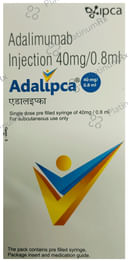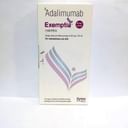Adalimumab
Uses
Adalimumab is used in the treatment of ulcerative colitis, Crohn's disease, psoriasis, ankylosing spondylitis, and rheumatoid arthritis.
How it Works
How Adalimumab works Adalimumab inhibits the action of specific chemical messengers that contribute to inflammation, swelling, and redness associated with certain joint diseases.
Side Effects
Common side effects of Adalimumab include sinus inflammation, upper respiratory tract infection, injection site reactions (such as pain, swelling, and redness), and infections.
Expert Advice
- Administered by injection under the skin (subcutaneous).
- Follow the dosage and duration recommended by your doctor.
- Notify your doctor immediately if you experience:
- Severe rash
- Hives
- Swelling of hands or face
- Shortness of breath
- Store the pen in the refrigerator.
- If refrigeration is not possible, the pen can be kept at room temperature (below 30°C) for up to 2 weeks.
- Do not freeze the pen.
- Do not discontinue the medication abruptly without consulting your doctor first.
Other Combinations
Related Medications
Adalimumab 40mg

₹21,825

₹13,750
MRP ₹25,000
Adalimumab 40mg

₹25,000

₹13,750
MRP ₹25,000
Adalimumab 40mg

₹23,999

₹13,750
MRP ₹25,000
Adalimumab 40mg

₹25,000

₹13,750
MRP ₹25,000
Adalimumab 40mg

₹25,000

₹13,750
MRP ₹25,000
Adalimumab 40mg

₹22,000

₹13,750
MRP ₹25,000
Adalimumab 40mg

₹22,321.4

₹13,750
MRP ₹25,000
Adalimumab 40mg

₹25,000

₹13,750
MRP ₹25,000
Adalimumab 40mg

₹25,000

₹13,750
MRP ₹25,000
Adalimumab 40mg

₹18,000

₹13,750
MRP ₹25,000
Adalimumab 40mg

₹9,999

₹13,750
MRP ₹25,000
Adalimumab 40mg

₹10,000

₹13,750
MRP ₹25,000
Adalimumab 40mg

₹23,437.5

₹13,750
MRP ₹25,000
Adalimumab 40mg

₹26,353.8

₹13,750
MRP ₹25,000
Adalimumab 40mg

₹26,000

₹13,750
MRP ₹25,000
Adalimumab 40mg

₹24,900

₹13,750
MRP ₹25,000
Adalimumab 40mg

₹13,750
MRP ₹25,000
Adalimumab 20mg

₹10,500

₹6,703.1
MRP ₹10,312.5
Adalimumab 20mg

₹25,000

₹6,703.1
MRP ₹10,312.5
Adalimumab 20mg

₹6,703.1
MRP ₹10,312.5